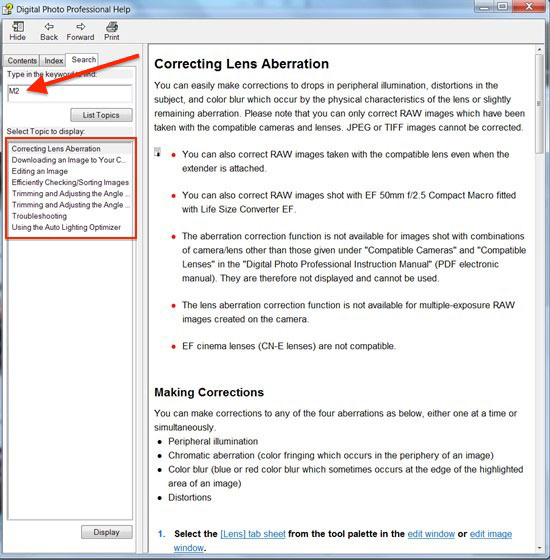Canon Eos Service Adjustment Software As A Service

Performing MA using remote AF We are going to use a map for this tutorial, first make sure your target is perfectly flat and pin it to the wall at a distance ~20 times the focal length, for a zoom lens choose the focal length that you use most often. First use the spirit level on the tripod head to level the camera in xy plane.
Forums > Equipment > Canon EOS > EOS 400D Adjustment / Service Software. Discussion in 'Canon EOS' started by mathew_levett, Sep 4, 2009.
It is essential that sensor plane is parallel to target. To do this you can use a small mirror, tape it to the target look through the camera’s finder until you can see the center of your lens in the mirror and lock down your tripod. Optical axis is now perpendicular to target and you are done with the mirror. 1) Connect the camera to your computer via the USB port, cancel any image download/pop-up application. 2) Run EOS utility. 3) Click on Camera setting/remote shooting icon. Introduction Thanks to scaling trends for CMOS image sensors most of today's DSLRs feature sensors with more than 12 million pixels, in order to take advantage of all of these pixels, it is essential that the projected image on the sensor be perfectly in focus.
Due to various tolerances in manufacturing and calibration at the factory, offset focus error may be present in camera’s AF sensor, AF lenses or both. The degree by which this offset error will affect the perceived sharpness of a photograph will depend on factors such as aperture and subject distance. In order to compensate for this offset error most manufacturers provide a firmware feature called ‘AF fine-tuning' or 'AF micro-adjustment'.
Here I explain an easy method to perform this correction in a more repeatable and consistent way. This method is primarily targeted for Canon and Nikon DSLRs which provide remote live view and remote focus actuation using manufacturer provided software. Other camera models can be calibrated similarly if firmware has identical capabilities. Understanding Micro-adjustment Before starting to perform AF micro-adjustment, it is important to understand what it can and what it can't do. MA can compensate for a fi xed and consistent shift in the focus system. Even when perfectly calibrated, the AF system in current EOS cameras is not always reliable, depending on the conditions, AF might miss its target and lock at a random distance, especially when tracking a moving subject in AI-servo mode.
MA will not help in these cases because the error is not due to a simple offset in the focus mechanism. Before performing any calibration you must confirm that there is a focus offset error in your camera/lens. Performing MA randomly in the hope of getting sharper images will just result in further confusion and frustration. For this purpose we are going to use a standard AF target and EOS viewer utility software that is included with all Canon DSLRs.
In order to use this method you need: Latest version of Canon EOS Utility software, you can download this from website. A Windows or Mac machine with a dual-core or better CPU capable of pulling live view from a DSLR in real time. Sturdy tripod placed on solid ground. A Focus target (anything with high contrast lines/patterns). Is a good example, you can also use a bank note. A small mirror. 11) Repeat this a few times until results are consistent.
12) Each click on the ( > ) or (. What Canon bodies and lenses are compatible with remote AF described above? Currently Canon EOS 50D,7D, 5D MKII and 1D MKIV support remote shooting, adjustment can be done with any EF or EF-S lens. Is this method applicable to Nikon cameras, what Nikon bodies and lenses are compatible? Yes, this method can also be used with Nikon cameras but you will need the Nikon Camera Control Pro 2 software (sold separately) to invoke the remote AF function. Currently Nikon D300, D300s, D7000, D700, D3, D3S and D3X with AF-S lenses support remote AF function. Can I use a different target for adjustment?
Absolutely, as long as target has enough contrast and remains perpendicular to optical axis. Does lowes install mailboxes. I get a different result every time I do micro adjustment, what should I do? In order to make a meaningful adjustment you need to first observer consistent front or back focus, each time, make at least 5-10 focus attempts, to make sure you get consistent results before performing any MA. Will the camera remember if a TC is attached to the lens? Is the MA applied to the active AF sensor or to all AF sensors? All AF sensors.
I get soft photos when shooting birds in flight in AI-servo mode, will MA help me get sharp flight images? “Micro” adjustment is primarily for fine-tuning static AF in order to achieve maximum sharpness for critical situations when DOF is extremely shallow (ex. Macro work at close range, portrait photography with wide open aperture etc.). The tolerance in the AF mechanism in all current Canon cameras in AI-servo and continuous-high shooting mode is at least 10 units or more on the MA scale so any fine adjustment is really irrelevant. Also keep in mind that for flight shots that are made at a reasonable distance there is always enough DOF to cover at least some parts of the bird, so even if the sharpest focus plane is slightly to the front or back it makes no visual difference in the output for flight conditions. Soft flight shots can happen for many reasons; it is extremely unlikely that you would achieve better flight performance by MA. I have performed MA with a zoom lens, I get good results at tele settings but at wide settings focus is bit worse, what should I do?